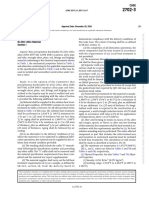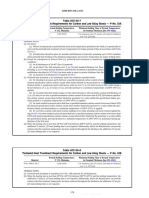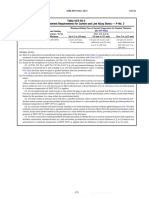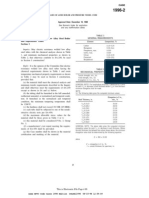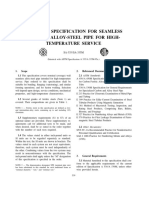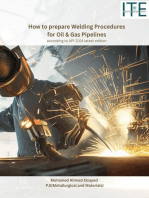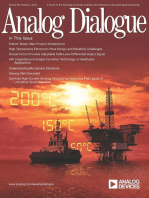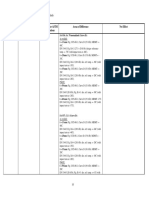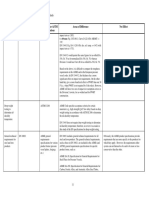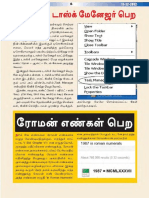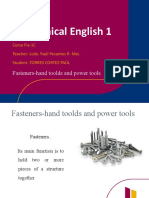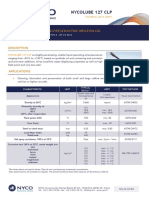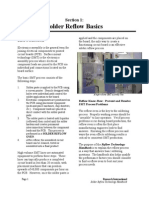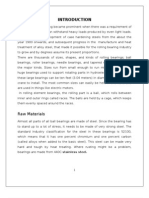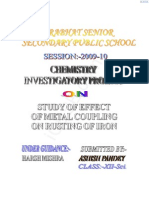Table UCS-56-11 Postweld Heat Treatment Requirements For Carbon and Low Alloy Steels - P-No. 15E
Table UCS-56-11 Postweld Heat Treatment Requirements For Carbon and Low Alloy Steels - P-No. 15E
Uploaded by
MechanicalCopyright:
Available Formats
Table UCS-56-11 Postweld Heat Treatment Requirements For Carbon and Low Alloy Steels - P-No. 15E
Table UCS-56-11 Postweld Heat Treatment Requirements For Carbon and Low Alloy Steels - P-No. 15E
Uploaded by
MechanicalOriginal Title
Copyright
Available Formats
Share this document
Did you find this document useful?
Is this content inappropriate?
Copyright:
Available Formats
Table UCS-56-11 Postweld Heat Treatment Requirements For Carbon and Low Alloy Steels - P-No. 15E
Table UCS-56-11 Postweld Heat Treatment Requirements For Carbon and Low Alloy Steels - P-No. 15E
Uploaded by
MechanicalCopyright:
Available Formats
UCS-56 ASME BPVC.VIII.
1-2019
ð19Þ Table UCS-56-11
Postweld Heat Treatment Requirements for Carbon and Low Alloy Steels — P-No. 15E
Minimum Holding Minimum Holding Time at Normal Temperature for Weld
Temperature, °F (°C) Maximum Holding Thickness (Nominal)
Material [Note (1)] and [Note (2)] Temperature, °F (°C) Up to 5 in. (125 mm) Over 5 in. (125 mm)
P‐No. 15E Group 1,300 (705) [Note (3)] and 1 hr/in. (2 min/mm), 30 min 5 hr plus 15 min for each additional
No. 1 [Note (4)] minimum inch (25 mm) over 5 in.
(125 mm)
GENERAL NOTES:
(a) Postweld heat treatment is not mandatory for electric resistance welds used to attach extended heat‐absorbing fins to pipe and tube ma-
terials, provided the following requirements are met:
(1) a maximum pipe or tube size of NPS 4 (DN 100)
(2) a maximum specified carbon content (SA material specification carbon content, except when further limited by the Purchaser to a
value within the specification limits) of not more than 0.15%
(3) a maximum fin thickness of 1/8 in. (3 mm)
(4) prior to using the welding procedure, the Manufacturer shall demonstrate that the heat‐affected zone does not encroach upon the
minimum wall thickness
(b) Postweld heat treatment is not mandatory for attaching bare-wire thermocouples by capacitor discharge welding or electric resistance
welding, provided
(1) the requirements of UCS-56(g) are met
(2) the maximum carbon content of the base material is restricted to 0.15%
(3) the minimum wall thickness is 0.20 in. (5 mm)
NOTES:
(1) If the nominal weld thickness is ≤ 0.5 in. (13 mm), the minimum holding temperature is 1,250°F (675°C).
(2) For dissimilar metal welds (i.e., welds made between a P‐No. 15E Group No. 1 and another lower chromium ferritic, austenitic, or nickel‐
based steel), if filler metal chromium content is less than 3.0% or if the filler metal is nickel‐based or austenitic, the minimum holding tem-
perature shall be 1,300°F (705°C).
(3) For welds made with matching Grade 91 filler metal (e.g., AWS A.5.5 E90xx-B91, ISO EN CrMo91), the maximum holding temperature shall
be determined as follows:
(a) If the Ni + Mn content of the filler metal is less than or equal to 1.0%, the maximum PWHT temperature shall be 1,455°F (790°C).
(b) If the Ni + Mn content of the filler metal is greater than 1.0% but less than or equal to 1.2%, the maximum PWHT temperature shall be
1,435°F (780°C).
(c) If the Ni + Mn content of the filler metal is greater than 1.2%, the maximum PWHT temperature shall be at least 20°F (10°C) below the
lower critical transformation temperature (Ac1) as determined by measurement of that temperature for the specific heat (or heats) of filler
metal to be used in accordance with ASTM A1033; in such case the following additional restrictions will apply:
(1) The Ac1 temperature of the filler metal as measured in accordance with ASTM A1033 shall be included in the Manufacturer’s Con-
struction Records.
(2) The maximum operating temperature for any vessel constructed using filler metal with a Ni + Mn content in excess of 1.2% shall be
975°F (525°C).
The lower transformation temperature for matching filler material is affected by alloy content, primarily the total of Ni + Mn. The max-
imum holding temperature has been set to avoid heat treatment in the intercritical zone.
(d) If multiple welds made with matching Grade 91 filler metal in a pressure part or pressure vessel are to be postweld heat treated at the
same time, the maximum PWHT temperature shall be determined based on the weld with the highest Ni + Mn content.
(4) If a portion of the component is heated above the heat treatment temperature allowed above, one of the following actions shall be
performed:
(a) The component in its entirety must be renormalized and tempered.
(b) If the maximum holding temperature in Note (3)(b) above is exceeded, but does not exceed 1,470°F (800°C), the weld metal shall be
removed and replaced.
(c) The portion of the component heated above 1,470°F (800°C) and at least 3 in. (75 mm) on either side of the overheated zone must be
removed and be renormalized and tempered or replaced.
(d) The allowable stress shall be that for Grade 9 material (i.e., SA-213‐T9, SA-335‐P9, or equivalent product specification) at the design
temperature, provided that the portion of the component heated to a temperature greater than that allowed above is reheat treated within
the temperature range specified above. To apply the provisions of this paragraph, the Manufacturer shall have qualified a WPS with repre-
sentative test specimens that accurately simulate the thermal history of the production part. Specifically, the qualification specimens shall
first be heat treated at a similar temperature for a similar time that violates the maximum holding temperature limit and then shall receive a
final heat treatment for the required time within the temperature range specified by this Table. The use of this provision shall be noted in
the Manufacturer’s Data Report.
180
Licensee=Khalda Petroleum/5986215001, User=Amer, Mohamed
No reproduction or networking permitted without license from IHS Not for Resale, 07/02/2019 13:29:04 MDT
ASME BPVC.VIII.1-2019 UCS-57 – UCS-66
Table UCS-56.1 LOW TEMPERATURE OPERATION
Alternative Postweld Heat Treatment UCS-65 SCOPE
Requirements for Carbon and Low Alloy The following paragraphs contain requirements for
Steels vessels and vessel parts constructed of carbon and low al-
Decrease in loy steels with respect to minimum design metal
Temperature Below temperatures.
Minimum Specified Minimum Holding Time
Temperature, [Note (1)] at Decreased UCS-66 MATERIALS ð19Þ
°F (°C) Temperature, hr Notes
(a) Unless exempted by the rules of UG-20(f) or other
50 (28) 2 …
100 (56) 4 … rules of this Division, Figure UCS-66 shall be used to es-
150 (83) 10 (2) tablish impact testing exemptions for steels listed in Part
200 (111) 20 (2) UCS. When Figure UCS-66 is used, impact testing is re-
quired for a combination of minimum design metal tem-
GENERAL NOTE: Applicable only when permitted in Tables
--`,``,``,,`,`,,````,`,``,,,`-`-`,,`,,`,`,,`---
perature (see UG-20) and governing thickness (as
UCS-56-1 through UCS-56-11.
defined below) that is below the curve assigned to the
NOTES: subject material. If a minimum design metal temperature
(1) Minimum holding time for 1 in. (25 mm) thickness or less. Add and governing thickness combination is on or above the
15 min per inch (25 mm) of thickness for thicknesses greater
curve, impact testing is not required by the rules of this
than 1 in. (25 mm).
(2) These lower postweld heat treatment temperatures permitted Division, except as required by (j) below and
only for P‐No. 1 Gr. Nos. 1 and 2 materials. UCS-67(a)(3) for weld metal. Components, such as shells,
heads, nozzles, manways, reinforcing pads, flanges, tube-
sheets, flat cover plates, backing strips which remain in
place, and attachments which are essential to the struc-
UCS-57 RADIOGRAPHIC EXAMINATION tural integrity of the vessel when welded to
In addition to the requirements of UW-11, complete pressure-retaining components, shall be treated as sepa-
radiographic examination is required for each butt- rate components. Each component shall be evaluated for
welded joint at which the thinner of the plate or vessel impact test requirements based on its individual material
wall thicknesses at the welded joint exceeds the thickness classification, governing thickness as defined in (1) and
limit above which full radiography is required in Table (2) below, and the minimum design metal temperature.
UCS-57. (1) The following governing thickness definitions ap-
ply when using Figure UCS-66:
(-a) Excluding castings, the governing thickness tg
of a welded part is as follows:
(-1) for butt joints except those in flat heads and
tubesheets, the nominal thickness of the thickest welded
Table UCS-57 joint [see Figure UCS-66.3, sketch (a)].
Thickness Above Which Full Radiographic (-2) for corner, fillet, or lap-welded joints, in-
Examination of Butt-Welded Joints Is cluding attachments as defined above, the thinner of the
Mandatory two parts joined.
(-3) for flat heads or tubesheets, the larger of
Nominal Thickness Above (-2) above or the flat component thickness divided by 4.
Which Butt-Welded Joints Shall (-4) for welded assemblies comprised of more
P‐No. and Group No. Be Fully Radiographed,
than two components (e.g., nozzle‐to‐shell joint with rein-
Classification of Material in. (mm)
forcing pad), the governing thickness and permissible
1 Gr. 1, 2, 3 11/4 (32)
3 Gr. 1, 2, 3 3
/4 (19)
minimum design metal temperature of each of the indivi-
4 Gr. 1, 2 5
/8 (16) dual welded joints of the assembly shall be determined,
5A Gr. 1, 2 0 (0) and the warmest of the minimum design metal tempera-
5B Gr. 1 0 (0) tures shall be used as the permissible minimum design
5C Gr. 1 0 (0) metal temperature of the welded assembly. [See Figure
15E, Gr. 1 0 (0) UCS-66.3, sketch (b).]
9A Gr. 1 5
/8 (16) (-5) if the governing thickness at any welded
5
9B Gr. 1 /8 (16) joint exceeds 4 in. (100 mm) and the minimum design me-
3
10A Gr. 1 /4 (19) tal temperature is colder than 120°F (50°C), impact tested
5
10B Gr. 1 /8 (16) material shall be used.
5
10C Gr. 1 /8 (16)
(-b) The governing thickness of a casting shall be
its largest nominal thickness.
181
Licensee=Khalda Petroleum/5986215001, User=Amer, Mohamed
No reproduction or networking permitted without license from IHS Not for Resale, 07/02/2019 13:29:04 MDT
UCS-66 ASME BPVC.VIII.1-2019
ð19Þ Figure UCS-66
Impact Test Exemption Curves
160
140
120
100
A [Note (1)]
B [Note (2)]
80
Minimum Design Metal Temperature, ºF
60
C [Note (3)]
40
D [Note (4)]
20
-20
-40
-55
-60
Impact testing required
-80
0.394 1 2 3 4 5 6
Governing Thickness, in.
[Limited to 4 in. for Welded Construction]
GENERAL NOTES:
(a) Tabular values for this figure are provided in Table UCS-66.
(b) See UCS-66(a).
(c) For bolting and nuts, the following impact test exemption temperatures shall apply:
Bolting
Spec. No. Grade Diameter, in. (mm) Impact Test Exemption Temperature, °F (°C)
SA-193 B5 Up to 4 (100), incl. −20 (−30)
SA-193 B7 Up to 21/2 in. (64), incl. −55 (−48)
SA-193 … Over 21/2 (64) to 7 (175), incl. −40 (−40)
SA-193 B7M Up to 21/2 (64), incl. −55 (−48)
182
Licensee=Khalda Petroleum/5986215001, User=Amer, Mohamed
No reproduction or networking permitted without license from IHS Not for Resale, 07/02/2019 13:29:04 MDT
ASME BPVC.VIII.1-2019 UCS-66
Figure UCS-66
Impact Test Exemption Curves (Cont'd)
GENERAL NOTES (CONT'D):
Table continued
Bolting
Spec. No. Grade Diameter, in. (mm) Impact Test Exemption Temperature, °F (°C)
SA-193 B16 Up to 7 (175), incl. −20 (−30)
SA-307 B All −20 (−30)
SA-320 L7, L7A, L7M Up to 21/2 (64), incl. See General Note (c) of Figure UG-84.1
SA-320 L43 Up to 1 (25), incl. See General Note (c) of Figure UG-84.1
SA-325 1 1
/2 (13) to 11/2 (38) −20 (−30)
SA-354 BC Up to 4 (100), incl. 0 (−18)
SA-354 BD Up to 4 (100), incl. +20 (−7)
SA-437 B4B, B4C All diameters See General Note (c) of Figure UG-84.1
SA-449 … Up to 3 (75), incl. −20 (−30)
SA-540 B21 Cl. All All Impact test required
SA-540 B22 Cl. 3 Up to 4 (100), incl. Impact test required
SA-540 B23 Cl. 1, 2 All Impact test required
SA-540 B23 Cl. 3, 4 Up to 6 (150), incl. See General Note (c) of Figure UG-84.1
SA-540 B23 Cl. 3, 4 Over 6 (150) to 91/2 (240), incl. Impact test required
SA-540 B23 Cl. 5 Up to 8 (200), incl. See General Note (c) of Figure UG-84.1
SA-540 B23 Cl. 5 Over 8 (200) to 91/2 (240), incl. Impact test required
SA-540 B24 Cl. 1 Up to 6 (150), incl. See General Note (c) of Figure UG-84.1
SA-540 B24 Cl. 1 Over 6 (150) to 8 (200), incl. Impact test required
SA-540 B24 Cl. 2 Up to 7 (175), incl. See General Note (c) of Figure UG-84.1
SA-540 B24 Cl. 2 Over 7 (175) to 91/2 (240), incl. Impact test required
SA-540 B24 Cl. 3, 4 Up to 8 (200), incl. See General Note (c) of Figure UG-84.1
SA-540 B24 Cl. 3, 4 Over 8 (200) to 91/2 (240), incl. Impact test required
SA-540 B24 Cl. 5 Up to 91/2 (240), incl. See General Note (c) of Figure UG-84.1
SA-540 B24V Cl. 3 All See General Note (c) of Figure UG-84.1
Nuts
Spec. No. Grade Impact Test Exemption Temperature, °F (°C)
SA-194 2, 2H, 2HM, 3, 4, 7, 7M, and 16 −55 (−48)
SA-540 B21/B22/B23/B24/B24V −55 (−48)
(d) When no class or grade is shown, all classes or grades are included.
(e) The following shall apply to all material assignment notes:
(1) Cooling rates faster than those obtained by cooling in air, followed by tempering, as permitted by the material specification, are
considered to be equivalent to normalizing or normalizing and tempering heat treatments.
(2) Fine grain practice is defined as the procedure necessary to obtain a fine austenitic grain size as described in SA-20.
(3) Normalized rolling condition is not considered as being equivalent to normalizing.
(f) Castings not listed in Notes (1) and (2) below shall be impact tested.
NOTES:
(1) Curve A applies to the following:
(a) all carbon and all low alloy steel plates, structural shapes, and bars not listed in Curves B, C, and D below
(b) SA-216 Grades WCB and WCC if normalized and tempered or water‐quenched and tempered; SA-217 Grade WC6 if normalized and
tempered or water‐quenched and tempered
(c) A/SA-105 forged flanges supplied in the as-forged condition
(2) Curve B applies to the following:
(a) see below:
A/SA-105 forged flanges produced to fine grain practice and normalized, normalized and tempered, or quenched and tempered after
forging
SA-216 Grade WCA if normalized and tempered or water‐quenched and tempered
SA-216 Grades WCB and WCC for thicknesses not exceeding 2 in. (50 mm) , if produced to fine grain practice and water‐quenched
and tempered
SA-217 Grade WC9 if normalized and tempered
SA-285 Grades A and B
SA-299
183
Licensee=Khalda Petroleum/5986215001, User=Amer, Mohamed
No reproduction or networking permitted without license from IHS Not for Resale, 07/02/2019 13:29:04 MDT
UCS-66 ASME BPVC.VIII.1-2019
Figure UCS-66
Impact Test Exemption Curves (Cont'd)
NOTES (CONT'D):
SA-414 Grade A
SA-515 Grade 60
SA-516 Grades 65 and 70 if not normalized
SA-612 if not normalized
SA-662 Grade B if not normalized
SA/EN 10028‐2 Grades P235GH, P265GH, P295GH, and P355GH as rolled
SA/AS 1548 Grades PT430NR and PT460NR
SA/GB 713 Grade Q345R if not normalized
(b) except for cast steels, all materials of Curve A, if produced to fine grain practice and normalized, that are not listed in Curves C and D
below
(c) all pipe, fittings, forgings and tubing not listed for Curves C and D below
(d) parts permitted under UG-11 even when fabricated from plate that otherwise would be assigned to a different curve
(3) Curve C applies to the following:
(a) see below:
SA-182 Grades F21 and F22 if normalized and tempered
SA-302 Grades C and D
SA-336 F21 and F22 if normalized and tempered, or liquid quenched and tempered
SA-387 Grades 21 and 22 if normalized and tempered, or liquid quenched and tempered
SA-516 Grades 55 and 60 if not normalized
SA-533 Types B and C Class 1
SA-662 Grade A
SA/EN 10028-2 Grade 10CrMo9–10 if normalized and tempered
(b) all materials listed in 2(a) and 2(c) for Curve B if produced to fine grain practice and normalized, normalized and tempered, or liquid
quenched and tempered as permitted in the material specification, and not listed for Curve D below
(4) Curve D applies to the following:
SA-203
SA-299 if normalized
SA-508 Grade 1
SA-516 if normalized or quenched and tempered
SA-524 Classes 1 and 2
SA-537 Classes 1, 2, and 3
SA-612 if normalized
SA-662 if normalized
SA-738 Grade A
SA-738 Grade A with Cb and V deliberately added in accordance with the provisions of the material specification, not colder than −20°F
(−29°C)
SA-738 Grade B not colder than −20°F (−29°C)
SA/AS 1548 Grades PT430N and PT460N
SA/EN 10028‐2 Grades P235GH, P265GH, P295GH, and P355GH if normalized
SA/EN 10028‐3 Grade P275NH
SA/GB 713 Grade Q345R if normalized
(-c) The governing thickness of flat nonwelded NOTE: The use of provisions in UCS-66 which waive the require-
parts, such as bolted flanges, tubesheets, and flat heads, ments for impact testing does not provide assurance that all test re-
is the flat component thickness divided by 4. sults for these materials would satisfy the impact energy
requirements of UG-84 if tested.
(-d) The governing thickness of a nonwelded
dished head [see Figure 1-6, sketch (c)] is the greater of (b) When the coincident ratio defined in Figure
the flat flange thickness divided by 4 or the minimum UCS-66.1 is less than one, Figure UCS-66.1 provides a ba-
thickness of the dished portion. sis for the use of components made of Part UCS materials
(-e) If the governing thickness of the nonwelded to have a colder MDMT than that derived from (a) above
part exceeds 6 in. (150 mm) and the minimum design me- without impact testing. Use of Figure UCS-66.1 is not per-
tal temperature is colder than 120°F (50°C), impact tested mitted for bolts and nuts.
material shall be used. (1) See below.
(2) Examples of the governing thickness for some ty- (-a) For such components, and for a MDMT of
pical vessel details are shown in Figure UCS-66.3. −55°F (−48°C) and warmer, the MDMT without impact
testing determined in (a) above for the given material
184
--`,``,``,,`,`,,````,`,``,,,`-`-`,,`,,`,`,,`---
Licensee=Khalda Petroleum/5986215001, User=Amer, Mohamed
No reproduction or networking permitted without license from IHS Not for Resale, 07/02/2019 13:29:04 MDT
ASME BPVC.VIII.1-2019 UCS-66
Figure UCS-66M ð19Þ
Impact Test Exemption Curves
70
60
50
40
A [Note (1)]
30
B [Note (2)]
Minimum Design Metal Temperature, ºC
20
C [Note (3)]
10
0
D [Note (4)]
-10
-20
-30
-40
-48
-50
Impact testing required
-60
10 20 40 60 80 100 120 140
Governing Thickness, mm
[Limited to 100 mm for Welded Construction]
GENERAL NOTES:
(a) Tabular values for this figure are provided in Table UCS-66.
(b) See UCS-66(a).
(c) For bolting and nuts, the following impact test exemption temperatures shall apply:
Bolting
Spec. No. Grade Diameter, in. (mm) Impact Test Exemption Temperature, °F (°C)
SA-193 B5 Up to 4 (100), incl. −20 (−30)
SA-193 B7 Up to 21/2 in. (64), incl. −55 (−48)
SA-193 … Over 21/2 (64) to 7 (175), incl. −40 (−40)
SA-193 B7M Up to 21/2 (64), incl. −55 (−48)
185 --`,``,``,,`,`,,````,`,``,,,`-`-`,,`,,`,`,,`---
Licensee=Khalda Petroleum/5986215001, User=Amer, Mohamed
No reproduction or networking permitted without license from IHS Not for Resale, 07/02/2019 13:29:04 MDT
You might also like
- Asme BPVC 2017 Code Case 2702-3Document6 pagesAsme BPVC 2017 Code Case 2702-3Anonymous lmCR3SkPrKNo ratings yet
- Brass DefectsDocument9 pagesBrass DefectstechopelessNo ratings yet
- Table UCS-56-1 Postweld Heat Treatment Requirements For Carbon and Low Alloy Steels - P-No. 1Document4 pagesTable UCS-56-1 Postweld Heat Treatment Requirements For Carbon and Low Alloy Steels - P-No. 1MechanicalNo ratings yet
- PWHT ProcedureDocument10 pagesPWHT ProcedureMohammed Kamal100% (11)
- Press Tool DesignDocument36 pagesPress Tool DesignAmar Bhopi100% (2)
- Table UCS-56-11 Postweld Heat Treatment Requirements For Carbon and Low Alloy Steels - P-No. 15EDocument5 pagesTable UCS-56-11 Postweld Heat Treatment Requirements For Carbon and Low Alloy Steels - P-No. 15EMechanicalNo ratings yet
- Table UCS-56-11 Postweld Heat Treatment Requirements For Carbon and Low Alloy Steels - P-No. 15EDocument1 pageTable UCS-56-11 Postweld Heat Treatment Requirements For Carbon and Low Alloy Steels - P-No. 15ECITRIXNo ratings yet
- Table Ucs 56 3 (P.no.4)Document1 pageTable Ucs 56 3 (P.no.4)Anonymous AyDvqgNo ratings yet
- Table UCS-56-7 Postweld Heat Treatment Requirements For Carbon and Low Alloy Steels - P-No. 10ADocument3 pagesTable UCS-56-7 Postweld Heat Treatment Requirements For Carbon and Low Alloy Steels - P-No. 10AMechanicalNo ratings yet
- Table UCS-56-7 Postweld Heat Treatment Requirements For Carbon and Low Alloy Steels - P-No. 10ADocument4 pagesTable UCS-56-7 Postweld Heat Treatment Requirements For Carbon and Low Alloy Steels - P-No. 10AMechanicalNo ratings yet
- Table UCS-56-7 Postweld Heat Treatment Requirements For Carbon and Low Alloy Steels - P-No. 10ADocument2 pagesTable UCS-56-7 Postweld Heat Treatment Requirements For Carbon and Low Alloy Steels - P-No. 10AMechanicalNo ratings yet
- PWHT, HT, Igc, MawpDocument40 pagesPWHT, HT, Igc, Mawpsachinshirnath100% (1)
- Heat Treatment of SS Clad CS After Fiber ElongationDocument3 pagesHeat Treatment of SS Clad CS After Fiber ElongationarifhonNo ratings yet
- Table Pw-39 Mandatory Requirements For Postweld Heat Treatment of Pressure Parts and Attachments (Coiijt'D)Document1 pageTable Pw-39 Mandatory Requirements For Postweld Heat Treatment of Pressure Parts and Attachments (Coiijt'D)Panchal ShaileshNo ratings yet
- Table UCS-56-2 Postweld Heat Treatment Requirements For Carbon and Low Alloy Steels - P-No. 3Document7 pagesTable UCS-56-2 Postweld Heat Treatment Requirements For Carbon and Low Alloy Steels - P-No. 3MechanicalNo ratings yet
- Asme N-7-1Document4 pagesAsme N-7-1pon sharonNo ratings yet
- Dillimax 690 eDocument4 pagesDillimax 690 ePrabhakar TiwariNo ratings yet
- Normalization and Temper Heat Treatment On P91Document6 pagesNormalization and Temper Heat Treatment On P91Asad Bin Ala Qatari100% (2)
- Table UCS-56-4 Postweld Heat Treatment Requirements For Carbon and Low Alloy Steels - P-Nos. 5A, 5B, and 5CDocument3 pagesTable UCS-56-4 Postweld Heat Treatment Requirements For Carbon and Low Alloy Steels - P-Nos. 5A, 5B, and 5CMechanicalNo ratings yet
- Asme Ccase - 2083Document2 pagesAsme Ccase - 2083ADAMJSRAONo ratings yet
- Table UCS-56-2 Postweld Heat Treatment Requirements For Carbon and Low Alloy Steels - P-No. 3Document1 pageTable UCS-56-2 Postweld Heat Treatment Requirements For Carbon and Low Alloy Steels - P-No. 3CITRIXNo ratings yet
- Code Case 183 - 2Document2 pagesCode Case 183 - 2Bruno ManzettiNo ratings yet
- Seamless and Welded Carbon and Alloy-Steel Tubes For Low-Temperature ServiceDocument6 pagesSeamless and Welded Carbon and Alloy-Steel Tubes For Low-Temperature ServiceAna Emily PrentissNo ratings yet
- P91 - Modified 9crmo: Alloy TypeDocument7 pagesP91 - Modified 9crmo: Alloy TypeHanLe DuyNo ratings yet
- Shell Petroleum Development Company: (Implemented/Issued For Review/Complete)Document17 pagesShell Petroleum Development Company: (Implemented/Issued For Review/Complete)Siva RamNo ratings yet
- Asme Section II A Sa-358 Sa-358mDocument10 pagesAsme Section II A Sa-358 Sa-358mAnonymous GhPzn1xNo ratings yet
- Appendix 27 Alternative Requirements For Glass-Lined VesselsDocument2 pagesAppendix 27 Alternative Requirements For Glass-Lined VesselsBinay K SrivastawaNo ratings yet
- NTPC 7th June Chetal SirDocument25 pagesNTPC 7th June Chetal Siraksit2102No ratings yet
- Astm A333Document7 pagesAstm A333Luis Evangelista Moura Pacheco100% (3)
- Asme CCase 1996-2Document2 pagesAsme CCase 1996-2ADAMJSRAONo ratings yet
- H99sec2asa 335Document4 pagesH99sec2asa 335Fermín VallejoNo ratings yet
- Post Weld Heat Treatment ProcedureDocument20 pagesPost Weld Heat Treatment Proceduresherviny100% (2)
- A 297 Heat Resistant Casting SteelDocument60 pagesA 297 Heat Resistant Casting SteelIr FankovicNo ratings yet
- Jpghrsghrb-905 (PWHT Procedure, Asme) Rev.0Document9 pagesJpghrsghrb-905 (PWHT Procedure, Asme) Rev.0Anoop N Kutty100% (1)
- Super Critical Power - Part42Document1 pageSuper Critical Power - Part42Dhiraj SatyamNo ratings yet
- Standard Specification For: Seamless and Welded Steel Pipe For Low-Temperature Service'Document10 pagesStandard Specification For: Seamless and Welded Steel Pipe For Low-Temperature Service'Chae Young LyuNo ratings yet
- ANSI B31.3 Tratamiento TermicoDocument6 pagesANSI B31.3 Tratamiento Termicoenemesio_85No ratings yet
- T000003407 - FileName1 - 6079A-B-590-006 Vol-2Document32 pagesT000003407 - FileName1 - 6079A-B-590-006 Vol-2kanchanabalajiNo ratings yet
- Heat Treatment of Welded JointsDocument3 pagesHeat Treatment of Welded JointsJlkKumarNo ratings yet
- Nhoih 7Document30 pagesNhoih 7ikgohlnNo ratings yet
- Grade 91 R 10-05 PDFDocument5 pagesGrade 91 R 10-05 PDFSarveshNo ratings yet
- Highlight WeldCanada CSA AWS Guides Preheat PWHTDocument5 pagesHighlight WeldCanada CSA AWS Guides Preheat PWHTAnonymous rYZyQQot55No ratings yet
- Ams-27593d HEAT TREATMENTDocument16 pagesAms-27593d HEAT TREATMENTGian GianNo ratings yet
- Strip Heater Technical CatalogueDocument8 pagesStrip Heater Technical CataloguechikoopandaNo ratings yet
- A 1014 - 03 QtewmtqDocument3 pagesA 1014 - 03 QtewmtqA MahmoodNo ratings yet
- Interview Question.Document7 pagesInterview Question.PankajDhobleNo ratings yet
- PWHT ProcedureDocument6 pagesPWHT ProcedurevictorbirlanNo ratings yet
- 3 05 A Welding Specification of Carbon Steel Alloy SteelDocument40 pages3 05 A Welding Specification of Carbon Steel Alloy SteelvancongthanhNo ratings yet
- ASTM A351 (Stainless Steel Castings)Document5 pagesASTM A351 (Stainless Steel Castings)Fendi MirandaNo ratings yet
- Dillimax 690: High Strength Fine Grained Structural Steel Quenched and TemperedDocument4 pagesDillimax 690: High Strength Fine Grained Structural Steel Quenched and TemperedBui Chi TamNo ratings yet
- Seamless and Welded Carbon and Alloy-Steel Tubes For Low-Temperature ServiceDocument6 pagesSeamless and Welded Carbon and Alloy-Steel Tubes For Low-Temperature ServiceAlphaEcc EngineeringTeamNo ratings yet
- Technological Challenges in Manufacturing of Heavy Reactors Using New Generation 2.25Cr-1Mo-0.25V SteelDocument10 pagesTechnological Challenges in Manufacturing of Heavy Reactors Using New Generation 2.25Cr-1Mo-0.25V Steelgovimano100% (1)
- B16 Case 11Document3 pagesB16 Case 11InaamNo ratings yet
- Sa 213Document11 pagesSa 213gst ajahNo ratings yet
- Asme Viii D 1aDocument8 pagesAsme Viii D 1aRICARDONo ratings yet
- TDC PP742 F2Document3 pagesTDC PP742 F2Arjun PrajapatiNo ratings yet
- How to prepare Welding Procedures for Oil & Gas PipelinesFrom EverandHow to prepare Welding Procedures for Oil & Gas PipelinesRating: 5 out of 5 stars5/5 (1)
- Proceedings of the 2014 Energy Materials Conference: Xi'an, Shaanxi Province, China, November 4 - 6, 2014From EverandProceedings of the 2014 Energy Materials Conference: Xi'an, Shaanxi Province, China, November 4 - 6, 2014No ratings yet
- Proceedings of the 8th International Symposium on Superalloy 718 and DerivativesFrom EverandProceedings of the 8th International Symposium on Superalloy 718 and DerivativesNo ratings yet
- Comparison of Asme Specifications - 2Document1 pageComparison of Asme Specifications - 2MechanicalNo ratings yet
- Comparison of Asme Specifications - 4Document1 pageComparison of Asme Specifications - 4MechanicalNo ratings yet
- Comparison of Asme Specifications - 3Document1 pageComparison of Asme Specifications - 3MechanicalNo ratings yet
- ), in I o Inc (: AstmDocument1 page), in I o Inc (: AstmMechanicalNo ratings yet
- Comparison of Asme Specifications - 5Document1 pageComparison of Asme Specifications - 5MechanicalNo ratings yet
- 5Document1 page5MechanicalNo ratings yet
- Pages From CMR 17-12-2012-4Document1 pagePages From CMR 17-12-2012-4MechanicalNo ratings yet
- Pages From CMR 17-12-2012Document1 pagePages From CMR 17-12-2012MechanicalNo ratings yet
- Pages From CMR 17-12-2012-5Document1 pagePages From CMR 17-12-2012-5MechanicalNo ratings yet
- Pages From CMR 17-12-2012-3Document1 pagePages From CMR 17-12-2012-3MechanicalNo ratings yet
- Pages From The Art of Thinking Clearly-8Document1 pagePages From The Art of Thinking Clearly-8MechanicalNo ratings yet
- Vasco 6000 EsiteDocument2 pagesVasco 6000 EsiteBruno GomesNo ratings yet
- EQT Plates ProductDocument12 pagesEQT Plates Productroberto.cruzNo ratings yet
- 17.weldability - McqsDocument5 pages17.weldability - McqsJawed AkhterNo ratings yet
- Periodic Table of The Elements Jul-2010Document2 pagesPeriodic Table of The Elements Jul-2010Arix MedinakuNo ratings yet
- Sintering of Powdered Copper: Brendan Short, Brendan Barrett, Jason Gamble Engineering 45, SRJC Fall 2011Document25 pagesSintering of Powdered Copper: Brendan Short, Brendan Barrett, Jason Gamble Engineering 45, SRJC Fall 2011476500No ratings yet
- Galvanic CorrosionDocument1 pageGalvanic CorrosionAndyNo ratings yet
- Lesson-1-3 (CE 321C)Document81 pagesLesson-1-3 (CE 321C)Andjie LeeNo ratings yet
- Welding PositionDocument30 pagesWelding PositionTuah Negeri100% (1)
- BBC Mitteilungen 1968 e 03Document95 pagesBBC Mitteilungen 1968 e 03frank775555No ratings yet
- PRODCUTIONDocument4 pagesPRODCUTIONvamsiNo ratings yet
- Material Specifications Data SheetDocument3 pagesMaterial Specifications Data SheetDoug Seybert100% (2)
- Grade 9 Chemistry Review ExerciseDocument6 pagesGrade 9 Chemistry Review ExerciseJacqueline LaiNo ratings yet
- Technical English 1: Fasteners-Hand Toolds and Power ToolsDocument28 pagesTechnical English 1: Fasteners-Hand Toolds and Power ToolsPaúl TorresNo ratings yet
- Nycolube 127 CLP: Cleaner, Lubricant and Preservative Weapon OilDocument1 pageNycolube 127 CLP: Cleaner, Lubricant and Preservative Weapon OilLavkush GuptaNo ratings yet
- Pipe Fittings InspectionDocument7 pagesPipe Fittings InspectionRamalingam PrabhakaranNo ratings yet
- Most Important Questions For Basic Manufacturing Processes (BME) 1Document2 pagesMost Important Questions For Basic Manufacturing Processes (BME) 1fgfdgdfgdfvvb100% (2)
- Reflow ManualDocument47 pagesReflow Manuallcnblzr3877100% (1)
- Gas Nitriding and Ferritic Nitrocarburizing - Nitriding SolutionsDocument8 pagesGas Nitriding and Ferritic Nitrocarburizing - Nitriding SolutionsCharlie BondNo ratings yet
- ASTM A802!A802M - 95 (Reapproved 2010) - STD Practice For Steel Castings Surface Acceptance STD & Visual ExaminationDocument3 pagesASTM A802!A802M - 95 (Reapproved 2010) - STD Practice For Steel Castings Surface Acceptance STD & Visual ExaminationJoe ScopeliteNo ratings yet
- Introduction To Rolling Element Bearing Manufacturing ProcessDocument18 pagesIntroduction To Rolling Element Bearing Manufacturing ProcessRamakanth P JoshiNo ratings yet
- Kishan 2024 Phys. Scr. 99 025979Document19 pagesKishan 2024 Phys. Scr. 99 025979Gold SuganthNo ratings yet
- Chapter 2 SolidificationDocument35 pagesChapter 2 SolidificationAyu ArtiniNo ratings yet
- Book Kongress-2019 ENG NEW SmalDocument339 pagesBook Kongress-2019 ENG NEW SmalChiheb Ba100% (1)
- Spe 76-202 Sep 2012Document8 pagesSpe 76-202 Sep 2012akashdruva892100% (1)
- Casting DefectsDocument38 pagesCasting Defectsዘረአዳም ዘመንቆረርNo ratings yet
- Effect of Metal Coupling O Rusting of IronDocument11 pagesEffect of Metal Coupling O Rusting of IronSourabh Roshan RamtekeNo ratings yet
- MB Daily 20140916Document30 pagesMB Daily 20140916Hoang ThanhNo ratings yet
- Materials Science and Engineering-Chapter 11Document3 pagesMaterials Science and Engineering-Chapter 11JurgenNo ratings yet
